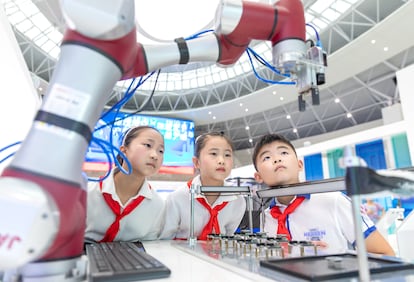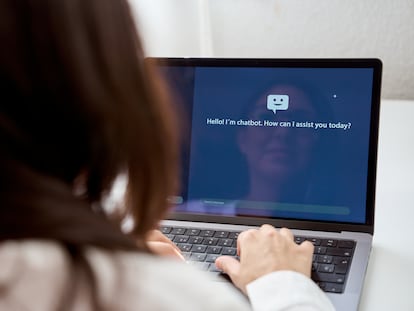Study highlights dangers AI poses to mental health of children and adolescents
According to research, one in 12 minors suffers some form of sexual abuse via the internet

Society could fall back into making the same mistake with artificial intelligence (AI) as it did with social media and the internet in general, The Lancet warns in a study published on January 21: when its effects — mainly on the mental health of minors — begin to be scientifically studied and action is taken based on the evidence, young people will have already adopted the new technology. “If we do not learn from past experiences, we may find ourselves in a similar situation in 10 years […] absorbed by another cycle of media panic and without managing to make AI safe and beneficial for children and adolescents,” warns Karen L. Mansfield, a research psychologist at the University of Oxford in the scientific publication, which also reveals one of those already established risks: one in 12 children is a victim of sexual abuse or exploitation every year in the world.
“On the internet you can find everything bad you can imagine, traffic for all kinds of things. It existed before the internet, but the internet has been a platform for global promotion and dissemination,” explains Jorge B., known online as @NoobInTheNet, and who began delving into the depths of the web at just 12 years of age. Thanks to the supervision of his parents and the initial guidance of the cybersecurity company Kaspersky, he was able to avoid the darkest paths. He is now 21 and works in the IT department of a multinational insurance company.
And the worst thing is that these doors to harm for children and adolescents are not inaccessible, but quite the opposite, as Jorge B. explains. “The worst thing you can find on the internet is not in a deep network that is difficult to find. The best way to hide something is to leave it in plain sight for everyone to see. You will find it on the surface in the most inappropriate place and at the most inappropriate time,” he says in relation to childhood and youth, when, in his words, “they lack a backpack with some experience and certain technological maturity.”
The worst thing you can find on the internet is not in a deep network that is difficult to find. The best way to hide something is to leave it in plain sight for everyone to see”Jorge B., @NoobInTheNet
Among the most common dangers of AI, the young specialist highlights impersonation through fake content, a practice that is prevalently targeted at girls and young people. Mansfield’s research points to more examples, especially those that have a direct impact on mental health. In this sense, she identifies “human-like functions” as potentially harmful, such as AI agents, or “producing images and video content convincing enough to be indistinguishable from authentic content [deepfakes and disinformation], which could influence children’s emotions and behaviour.” The psychologist also points to “content recommendation systems and online diagnostic tools for depression, anxiety, or eating disorders, which are increasingly used for self-diagnosis.”
“With human-like AI enhancing or moderating online interactions, the range of potential benefits and harms for children and teens is more diverse than social media and online gaming alone have ever been,” Mansfield warns.
Marc Rivero, lead security researcher at Kaspersky and unrelated to the study, comes to a similar conclusion: “Artificial intelligence is transforming the digital experience of children and adolescents, but it can also have a negative impact on their mental and emotional health. By personalizing the content they see and suggesting interactions, AI can expose them to inappropriate materials or online groups that promote illegal activities. These influences can increase anxiety and isolation, or even lead to risky behavior in the digital environment. Therefore, it is key to protect minors through early digital education, the use of appropriate monitoring tools such as parental controls, and the establishment of an open dialogue with children to teach them how to navigate the digital world safely and responsibly.”
By personalizing the content they see and suggesting interactions, AI can expose them to inappropriate materials or online groups that promote illegal activities”Marc Rivero, lead security researcher at Kaspersky
The warning from Rivero and the Oxford researchers is especially relevant because, according to the Kaspersky report Being online: children and parents on the internet, “most children have access to technology from an early age: almost half of Spanish minors (47%) have their first contact with an internet-connected device before they turn seven: 24.5% of Spanish parents never talk to their children about the dangers of the digital environment and 75% admit that their child did not have sufficient knowledge to use the internet safely.”
All the specialists consulted agree on three key points: training, information, and research so that access to AI resources is managed with the greatest possible protections. Without these, subsequent regulations or prohibitions on the use of the technology are ineffective.
Child abuse
This has been demonstrated by one of the worst scourges of the internet, where rules and limits have not prevented one in 12 children in the world per year from suffering sexual exploitation or abuse. This is the conclusion of a study led by Deborah Fry, professor of child protection research at the University of Edinburgh, which was also published in The Lancet.
Like the Oxford study, this paper also points to the danger of AI disruption. “Emerging technologies based on advances in both hardware and software are drawing on decades of AI research. The ways young people interact with AI are constantly changing, and many experts predict human-like AI within the next decade,” Fry warns in the research.
The child protection specialist's team points out the limitations of research based on screen time or social media use. It is also suspicious of measures linked to these two aspects: “Time limits [on browsing] and age limits [on accessing applications] shift the responsibility away from the need to regulate harmful content, placing the responsibility instead on parents and guardians or on the massive integration of untested age estimation technologies, which have been considered to present risks to privacy and security.”
Researchers also point to the lack of uniform and homogeneous data to address a global problem. In fact, there is not even a unified approach in considering sexual crimes and abuse on the internet.
Sign up for our weekly newsletter to get more English-language news coverage from EL PAÍS USA Edition
Tu suscripción se está usando en otro dispositivo
¿Quieres añadir otro usuario a tu suscripción?
Si continúas leyendo en este dispositivo, no se podrá leer en el otro.
FlechaTu suscripción se está usando en otro dispositivo y solo puedes acceder a EL PAÍS desde un dispositivo a la vez.
Si quieres compartir tu cuenta, cambia tu suscripción a la modalidad Premium, así podrás añadir otro usuario. Cada uno accederá con su propia cuenta de email, lo que os permitirá personalizar vuestra experiencia en EL PAÍS.
¿Tienes una suscripción de empresa? Accede aquí para contratar más cuentas.
En el caso de no saber quién está usando tu cuenta, te recomendamos cambiar tu contraseña aquí.
Si decides continuar compartiendo tu cuenta, este mensaje se mostrará en tu dispositivo y en el de la otra persona que está usando tu cuenta de forma indefinida, afectando a tu experiencia de lectura. Puedes consultar aquí los términos y condiciones de la suscripción digital.
More information
Archived In
Últimas noticias
Chris Martin, Taylor Swift, Elijah Wood and other famous wedding ‘crashers’
‘How does it feel to be a failure?’: Elizabeth Berkley’s journey from ‘Showgirls’ ridicule to vindication
The story of the Málaga virus: The code that haunted Google’s cybersecurity center director for 30 years
The impact of Ecuador’s mega-prison: A polluted river, cleared forests and military checkpoints
Most viewed
- Christian Louboutin: ‘Young people don’t want to be like their parents. And if their parents wear sneakers, they’re going to look for something else’
- The low-cost creative revolution: How technology is making art accessible to everyone
- All the effects of gentrification in one corner of Mexico’s Colonia Roma
- Liset Menéndez de la Prida, neuroscientist: ‘It’s not normal to constantly seek pleasure; it’s important to be bored, to be calm’
- December Social Security and SSI payments: Dates, double checks and the 2026 COLA increase











































